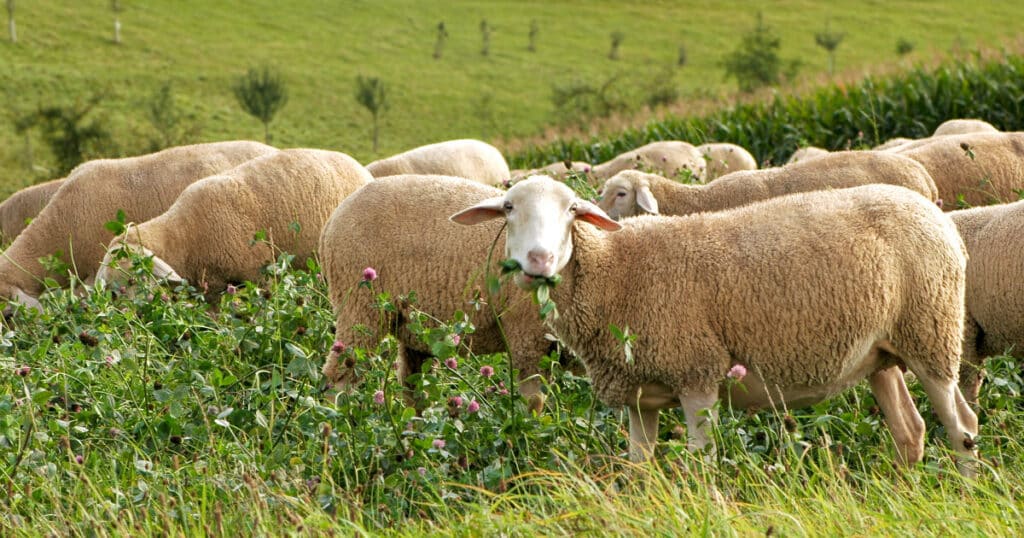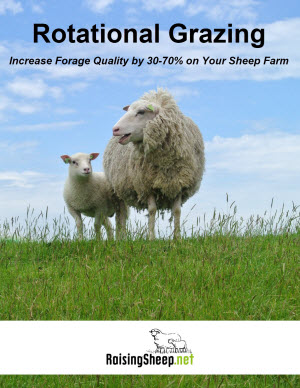Whether you’re a new shepherd or you’re just curious and want to learn a little more about sheep food – it’s important to answer the question: “What do sheep eat?” Providing sheep with proper nutrition is the key to a thriving flock.
Proper sheep nutrition must meet three key criteria:
- Quantity
- Quality
- Balance
More on that later. First lets cover the most common types of sheep food so you can learn a little more about what sheep eat and why.
Get Your FREE Rotational Grazing Guide
This 16-page PDF is packed with our best information and tips to start increasing forage quality 30-70% in your pasture.
- Discover the science behind rotational grazing.
- Learn how you can improve forage quality and quantity.
- Discover creative ways you can manage your grasslands.
- Get helpful tips that can help you cut feed costs for your flock.
- Understand the trade-offs in switching to rotational grazing.
Basic Sheep Food: Clover, Grass, and Forbs
For the most part sheep eat grass, clover (and other legumes), forbs and other pasture plants native to the area they live in.
Legumes like red clover (pictured), vetch and alfalfa offer an incredibly high nutritional value. They are some of the best foods for sheep. If you’re able to grow these plants in your pasture then you certainly should. But be careful about overgrazing; this will destroy the roots and eradicate these valuable plants.
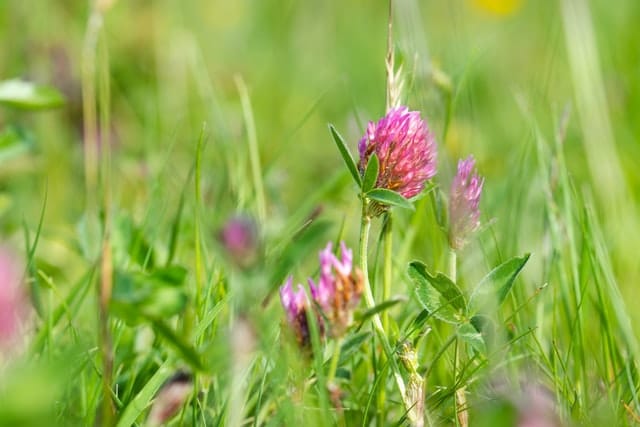
Sheep tend to love to consume forbs (broad leaf plants other than grass). If there is ample food available in their pasture they’ll skip the grass in favor of these rugged, leafy plants.
In general sheep tend to be picky eaters. They prefer leafy plants to plants which have fibrous stalks. With that said, sheep adapt to their environment well, and will eat nearly anything with nutritional value.
Compared to cattle, sheep are more picky grazers which will select the most nutritious pasture growth first.
When do Sheep Graze and How Much Land Do You Need?
Now you know something about what sheep eat. But it may surprise you to learn how often they eat and how much they consume.
A sheep will graze up to seven hours a day if the pasture is available. They prefer to eat in the cooler hours early in the morning and late in the afternoon. They will rarely explore their pasture after dark due to a fear of predation.
Sheep are gregarious – a term which means they prefer to travel in a flock. It’s common to see your entire flock of sheep grazing together. They’ll eat grasses in one part of your pasture at a time, slowly moving together into new grasses.
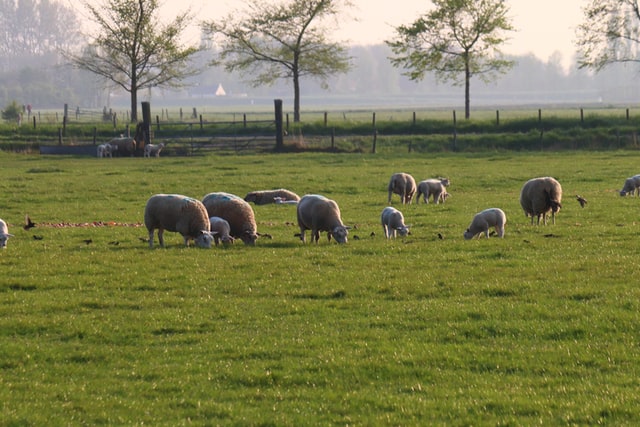
The amount of land required to feed a sheep will be determined by the quality of the soil and the amount of rainfall your area receives.
Management of the pasture (including proper rotational grazing) will also determine how much land is required to feed your flock of sheep.
An acre of pasture in a dry climate will not support as many sheep as an acre of pasture in areas with plenty of rain. The size of range land your sheep require will increase during the dry season (usually summer).
It may surprise you, but an improved acre of grassland in Maryland could support ten sheep whereas the arid ranges of West Texas may require ten acres to support a single sheep’s nutrition requirements.
The amount of nutrition your sheep require and what your sheep need to eat is determined by their role on your farm.
Pregnant or nursing ewes require more nutrition. Ewes who are not raising lambs, but are instead only producing wool can do so effectively while eating less.
What Do Sheep Eat When Grass Isn’t Available?
You may be wondering what sheep eat when there isn’t grass available; either during drought, winter or when they are kept in stalls at the county fair.
When fresh grass is not available, sheep are typically fed some combination of stored foods. These include hay, silage, haylage, or crop by-products like corn, barley, etc.
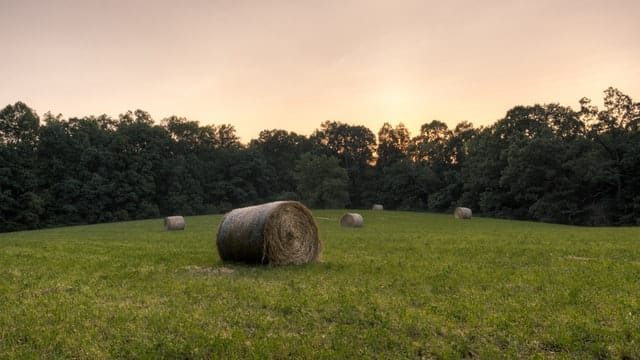
Hay is grass which is cut and then dried prior to storage. In this way it is available for farmers to feed to their sheep during months when grazing isn’t an option.
Silage is green forage which is fermented instead of being dried and cured like hay. This is stored in a silo or other system which keeps air out. It’s important if you’re feeding haylage or silage that it not be moldy as this can cause listeriosis (commonly called “circling disease”) in sheep. It’s also important to chop the pieces of silage smaller for sheep – they may not be able to process large pieces intended for cattle.
In some parts of the world pasture plants are cut, chopped and brought to feedlots. There it is fed to sheep, saving them a trip to the pasture. This freshly harvested forage is referred to as “green chop” and it’s a common method of feeding sheep in developing countries where labor is readily available.
Some hardy sheep in Maine are raised on uninhabited islands just off the coast. They subsist each winter on seaweed which washes ashore, delivering their lambs unassisted in the cold ocean air.
While you may think of sheep as soft, woolly animals it’s important to remember how versatile they are and marvel at how easily sheep adapt to the conditions and the foods which are available to them.
Sheep Food: Grain and Supplements
While processed grains may not be available to sheep in the wild, domestic sheep with elevated nutritional needs often eat grains.
Examples include pregnant ewes during the final stages of gestation and show lambs with a high genetic potential for growth. These lambs require more nutrition to achieve their maximum growth rate. The grain fed to sheep consists of the seed portion of crops such as corn, barley, oats and others. While it is a processed food it’s not unnatural for sheep, as the primary ingredients all come from nature. If these plants were available in a pasture sheep would certainly gobble them up!
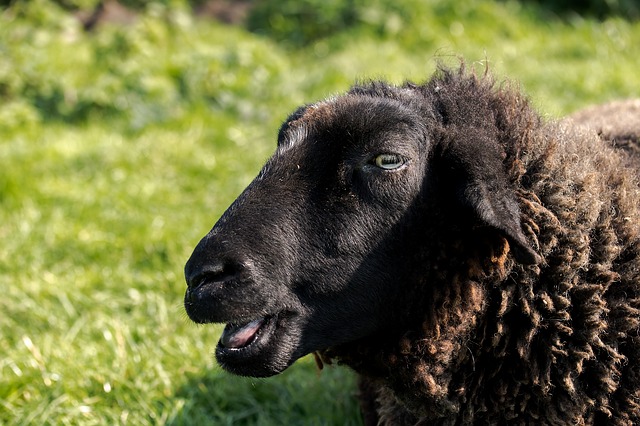
Many sheep grains include protein sources such as cottonseed or soybean meal. It’s common for vitamins and minerals to also be added to make commercial grains a nutritionally balanced. Think of it as a healthy granola bar when the mixture is done in a balanced way. But if the grain is unbalanced you could compare each serving to an unhealthy processed human food source. Make sure you read the label so you know what your sheep are eating.
READ: Best Mineral Blocks & Salt Licks for Sheep
One challenge for shepherds who feed grain is regulating grain consumption. Sheep love the taste of grain and there’s a risk that if left unregulated they will consume too much, too fast and fall ill. Whenever you introduce grain to a sheep’s diet do so gradually, feeding a little more each day until they are consuming the proper ration for their size and nutritional needs. Remember that sheep are ruminants and as such they should always have some roughage in their diets – at least one pound per adult sheep per day. This can come in the form of hay, pasture and other roughage which is fibrous and aids digestion.
What Else Do Sheep Eat?
The single most important thing that sheep consume is fresh, clean water and it’s critical that your sheep have constant access to water so that they can be healthy, happy and thrive. With that said, the amount of water your sheep need to drink will vary based on the sheep’s age, condition, production level (is it a nursing or pregnant ewe or a ram tasked with breeding your entire flock?) and also the nutritional content of its food. If your sheep are consuming wet feed such as haylage or if you’re in a climate where the pasture they graze each morning has a heavy dew on it your sheep will likely require less water than if they’re covering more ground to browse for lean pickings in West Texas or the California sun.
A good rule of thumb for any shepherd is to do their homework, find out the particular nutritional requirements for the breed of sheep in their flock, and then to make smart, educated decisions about pasture management which will allow their sheep to eat the proper food. If this article has helped answer the question “What do sheep eat?” then we invite you to subscribe to our mailing list or share this site with a friend.

